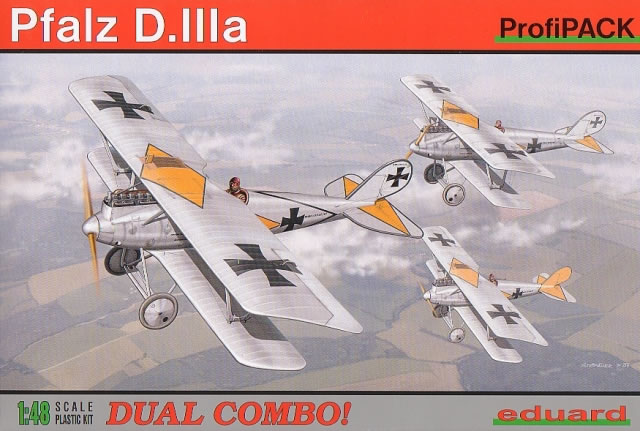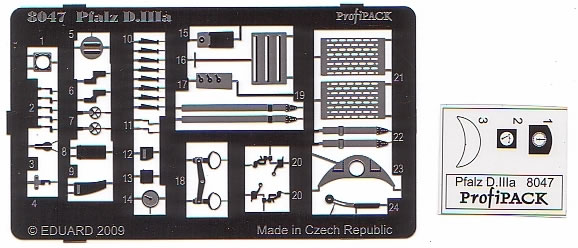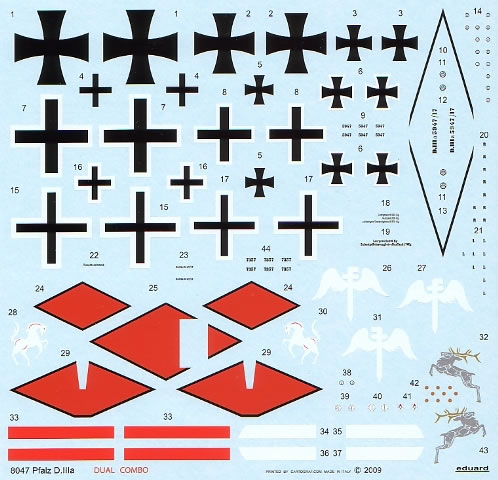|
Pfalz D.IIIA ProfiPACK
Dual Combo

Eduard, 1/48 scale
S
u m m a r y |
| Catalogue Number: |
Eduard Kit No. 8047 - Pfalz D.IIIa ProfiPACK “Dual Combo” |
| Scale: |
1/48 |
| Contents and Media: |
170 parts in tan coloured plastic; 29 photo-eched parts; 6 clear parts; markings for four aircraft |
| Price: |
USD$74.95 available online from Eduard
and hobby retailers worldwide |
| Review Type: |
FirstLook |
| Advantages: |
Accurate outline; crisply moulded plastic parts; good use of photo etched parts; nicely printed decal sheet with minimal carrier film and perfect register. |
| Disadvantages: |
|
| Conclusion: |
The welcome repackaging of an old favourite in the ever popular “Dual Combo” series. This is a sound, easy to build kit that is helped by a fret of extras to bring it in line with today’s expectations. |
Reviewed by
Rob Baumgartner

Eduard's 1/48 Pfalz D.IIIa Dual Combo is available online from Squadron.com
There’s a lot to like about the Pfalz D.IIIa. Its elegant lines and colourful markings make it a perennial favourite amongst WWI aviation buffs.
Eduard released their 1:48 scale version of this aircraft nearly 10 years ago and even now it holds up well. Two have been combined in this issue, and along with a couple of photo-etched frets, creates the latest “Dual Combo ProfiPACK” from this manufacturer.
Despite the passing of time, all parts are still crisply moulded with no flash or imperfections. Each has two sprues of tan coloured plastic containing a total of 55 pieces. A pair of frets compliments this, with each representing 42 items of p-e. An acetate sheet takes care of the windscreen and also provides for a preprinted instrument panel. Not to be forgotten is a mask set for the wheel and tail décor as well as a decal sheet that showcases 4 colourful aircraft.
It appears that the scale plans of Steve Simkin were used for the production of this kit as the major components match his outlines almost perfectly. These were published many moons ago in Albatros Productions Datafile No. 21.
The cockpit is well catered for and includes both plastic and photo-etched items. The latter takes care of the switches, trigger levers, rudder bar (with foot straps), and seat belts. This all looks convincing when added to the inner structure which one finds as part of the fuselage interior.
The wings are superbly moulded single piece affairs with sharp trailing edges and no distortion whatsoever. At first sight we notice that the upper surface ribs are a little heavier than usual but not so much as to cause a major drama.
Each machine gun receives the p-e treatment with extra detailing provided for both ends.

The fretted jackets look great as do the new sights and cocking handles. More is used for the radiator and this takes care of the shutter lever and its related cover. A belly strap between the undercarriage legs would have been handy in this material as this is missing from the main moulding.
The fit of the parts is very good with only a modicum of filler needed to blend in the flying surfaces. Some of the smaller pieces need a degree of test-fitting but essentially it’s all easy work for even the novice builder.
Once the top wing is on, a couple of radiator pipes fashioned spare rod will add a nice finishing touch. If you wish to rig your aircraft, a diagram provides for this in the instruction booklet.
Marking Options
\The large decal sheet caters for 4 subjects although a fifth can be added if one looks at the side of the box. Decals are supplied for this extra subject (Ltn. Hans-Georg von der Marwitz) but note that certain profile combinations are not able to be built together; this being due to the shared nature of the National markings.

As expected all of the items were printed perfectly. There were no registration issues and carrier film was both thin and kept to a minimum.
- Carl Degelow, Jasta 7, March 1918.
Degelow scored 30 confirmed victories before the war’s end and was the last airman to receive the coveted “Blue Max”. The aircraft of his victims included such types as the Sopwith Camel, SE5a, DH9, Spad XIII, F2b Caudron GIV and even a balloon.
When painting this machine, note that some sources suggest black as the colour used for covering the wings.
- Rudolf Berthold, Commander of JG II, 1918.
After scoring 5 of 44 confirmed victories, Berthold also gained the first of many injuries that he would endure during the war. Such was his devotion to duty, he regularly returned to combat before his wounds had suitably healed.
Over the course of his career he suffered a fractured skull, broken nose, pelvis, thigh, as well as a shattered right arm due to the inevitable enemy bullet.
Eduard shows one interpretation of the red/blue demarcation point. Another is that this line appeared just in front of the rear cabane strut.
- Jasta 5, Spring 1918
This is a colourful yet unidentifiable machine from the Jasta 5 stables.
The photo that this profile comes from is not very clear and thus there is some conjecture regarding the portrayed markings.
- Hans-Joachim Buddecke, Jasta 30, early 1918
Buddecke spent much of his time fighting in Turkey where he became the third airman to be awarded the Pour le Merite. After a brief return to the Western Front to lead Jasta 4, the ace returned to his original hunting ground to complete a second “tour of duty” and gained two more victories to bring his score to 12. The type of opposition he faced there didn’t prepare him for his subsequent return to France. He was shot down and killed by Sopwith Camels from No. 3 Naval Squadron only a few weeks later. His final tally was 13.
The elegant Pfalz makes a welcome return in the popular “Dual Combo” boxing.
Plenty is made of the attractive colour schemes these fighters wore and the inclusion of the photo-etched parts help to maintain a level of detail expected by today’s modellers. More recent published photos of Jasta 30 aircraft have made manufacturers aware that the unit’s diamond emblem also appears on the upper wing. This hasn’t always been reflected in kits but it’s great to see that Eduard has included it here.
For those that missed these subjects the first time round, here’s the perfect opportunity to grab a double dose to satisfy your craving.
Thanks to Eduard for the sample
Review Text Copyright © 2009 by Rob Baumgartner
Page Created 16 July, 2009
Last updated
17 July, 2009
Back to HyperScale Main Page
Back to Reviews Page

|
